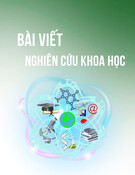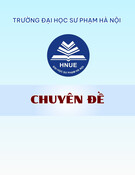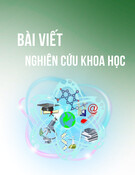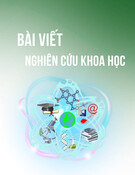
Hue University Journal of Science: Social Sciences and Humanities
ISSN 2588-1213
Vol. 133, No. 6B, 2024, p.p. 23–44, DOI: 10.26459/hueunijssh.v133i6A.7108
EFL LEARNER ENGAGEMENT IN GAMIFIED FORMATIVE
ASSESSMENT: A PERCEPTION STUDY ON QUIZIZZ
Hoang Thị Linh Giang *
University of Foreign Languages, Hue University, 57 Nguyen Khoa Chiem St., Hue, Vietnam
* Correspondence to Hoang Thi Linh Giang < htlgiang@hueuni.edu.vn>
(Received: February 13, 2023; Accepted: August 20, 2023)
Abstract. Among several technological applications in education, Quizizz is an increasingly popular
gamification platform to deliver tests and e-quizzes in different teaching contexts. However, the
discussion about how gamified assessments via online platforms influence teaching and learning is neither
profoundly theorized nor well supported with empirical evidence. The current research attempts to
explore Vietnamese university students’ perceptions of the impacts of gamified formative tests on Quizizz
by adopting the tripartite framework of affective, behavioral, and cognitive engagement. The sample
includes 54 English-majored students who were taking a course in designing tests for young language
learners. Based on data collected from a questionnaire and semi-structured interviews, the current
research found students’ highly positive perceived affective engagement in Quizizz-based formative tests.
Their self-report active participation in the e-quizzes and follow-up teacher/peer feedback sessions
demonstrated high levels of behavioral engagement. Students were, however, slightly less in agreement
with the benefits of Quizizz in enhancing their self-monitoring and critical thinking skills. Some
reservations remain about technical problems during quiz administration and the use of scores in Quizizz
gamified tests for summative assessment purposes. The findings inform pedagogical implications about
the use of gamified platforms to better engage students effectively, behaviourally, and cognitively.
Keywords: Quizizz; Formative assessments; Learner engagement; Affective, behavioural, and cognitive
engagement.
1. Introduction
Born in the 21st century, learners at different educational levels are called “digital
natives”, being owners of smart devices and experienced users of Internet services. Thus, the
education system is faced with the challenge to keep abreast of technological advances and
tailor itself to the needs of digital natives to better support their learning [5]. Technology has
gradually taken on vital roles in different teaching and learning contexts. In the English as a
foreign language (EFL) context of Vietnam, various digital tools have been used to supplement






























